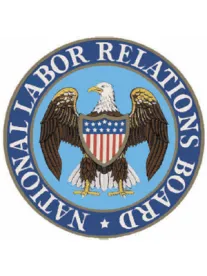As we hurtle toward Labor Day, and the probable onslaught of decisions, and as NLRB Member Pearce’s tenure ends on August 27, the Board has been issuing a steady stream of cases. Many of these appear to be garden variety type cases, with a smattering of cases now dismissing the theory of a class action waiver violation and some defaults.
Recently, the Board issued a pretty interesting case concerning an alleged threat to an employee, as well as a fairly novel theory where “constructive discharge” principles were applied to an alleged denial of a transfer between two jobs at an employer.
In Mercy Hospital, 366 NLRB No. 165 (August 20, 2018), a three member panel of the Board (Pearce, McFerran and Kaplan) addressed a number of allegations against a unionized medical center. The Administrative Law Judge found numerous unfair labor practices, including that the employer had issued a threat to an employee and constructively denied the same employee a transfer to a different job. On appeal, the Board reversed both of these findings.
Background
The employer runs a medical center providing clinical and acute care health services. The Certified Nursing Assistances (CNAs) are represented by a union. One CNA “often expressed work-related concerns to her supervisors in team huddle meetings and by email.” In October 2014, the CNA received a performance review that praised her work but also stated she needed to improve “communication with supervisors, her acceptance of direction and constructive criticism.”
A few months later, in May 2015, during a team huddle meeting the CNA asked about new work assignments in a forthcoming mother-baby birthing center. A manager later approached the CNA and told her that she should ask supervision directly about new assignments and not ask them in the huddle meetings.
In late June 2015, the CNA received a “Level 1 conversation” regarding her attendance issues. The Level 1 does not constitute official discipline, nor is it included in the employee’s personnel file. It also cannot be used for further corrective action but lasts 6 months/ In October 2015, after the CNA continued to have attendance problems, this was elevated to a Level 2 conversation.
In October 2015, the CNA sought to transfer to a CNA position in the Intensive Care Unit (ICU). Under the terms of the parties’ collective bargaining agreement, the CNA was entitled to the position. The CNA had a routine “meet and greet” with the head of the ICU. Per the parties’ bargaining agreement a transfer could not be denied but the meeting allows the department manager and employee the opportunity to get to know one another. The ICU manager told the CNA the workload in the ICU was “significant” and that the employees often had to “hustle” and work as a team. The ICU manager stated she felt the CNA’s attendance issues were a concern. The ICU manager also stated that the CNA’s current supervisor told her that the CNA was “inappropriate, rude and disrespectful” and was not a “team player.” The CNA was upset and defended herself claiming past absences were covered by FMLA. The ICU manager stated that she would continue to monitor the CNA and “utilize corrective action should any attendance or behavior problems persist.”
The employee declined the transfer, and subsequently transferred to another position in medical center’s operating room.
After trial, the ALJ found a number of violations. One such violation was that the employer violated Section 8(a)(1) when its manager told the CNA in May 2015 that she should not raise questions about job bids in a group context. The ALJ also found that the conversation between the ICU manager and the CNA was unlawful because it related to the CNA’s past protected activities. Further, the ALJ found that the ICU manager’s statement that she would monitor the CNA’s attendance and work behavior constituted a constructive denial of transfer where the CNA was given a Hobson’s Choice to discontinue her protected activities or face discipline.
Did the Meet and Greet Reasonably Tend to Coerce the Employee in the Exercise of Her Section 7 Rights?
The ALJ found that the CNA’s conduct during the huddle meetings was protected concerted activity, including when she expressed work related concerns and when she asked about new work assignments. The ALJ found the employer violated Section 8(a)(1) of the Act when the ICU manager told the CNA that her supervisor said the CNA was inappropriate and disrespectful and when the ICU manager informed the CNA her work would be monitored.
The Board majority (McFerran and Kaplan) reversed this finding. The Board recited the relevant standard in evaluating statements as coercive: “The relevant inquiry is an objective one: whether the employer’s statements or actions would tend to coerce a reasonable employee and chill the exercise of the employee’s Section 7 rights.” The Board then noted several reasons why this comment did not reasonably chill the CNA in exercise of her Section 7 rights.
First, there was no reason to believe the ICU manager had any knowledge of the protected activities of the CNA. In this regard, the Board noted that the meet and greet where the alleged threat occurred was “4 or 5” months after the meeting where the CNA inquired about work assignments. There was no evidence the ICU manager attended that prior meeting. While the ALJ noted the CNA took an “active” role in raising work related concerns it was “difficult to infer that [the CNA’s current manager’s] broadly negative characterization of [the CNA’s] work performance” referred to the protected activity.
Second, the Board noted that a “reasonable employee in [the CNA’s position] would have recognized that there was ample reason unrelated to protected conduct for” a prospective manager to be concerned. In this regard, the Board noted that for two years the CNA had been warned aobut “indulging in nonverbal expressions of impatience and displeasure at team huddle meetings, such as rolling her eyes, sitting with arms crossed and breathing heavily.” The Board concluded that a reasonable employee in the CNA’s position would assume that the manager of the unit to which she intended to transfer would know of these issues.
The Board found it significant that the ICU manager said nothing about protected activities and that a reasonable manager would be concerned about the CNA’s performance.
Constructive Denial of a Transfer? A Novel But Ultimately Unavailing Theory
The Board also reversed the ALJs finding that the CNA’s turning down the job based on the ICU manager’s remarks was an unfair labor practice. The ALJ ruled that the ICU manager presented the CNA with a Hobson’s Choice of accepting the ICU position and facing discipline or declining the position “even though she was entitled to it as the most senior qualified applicant.”
The Board was careful to note that it was not deciding the viability of this theory (which means they didn’t think much of it) but concluded that the CNA was not presented with a Hobson’s choice. The Board noted that under the theory of Hobson’s Choice constructive discharge “an employee’s voluntary quit will be considered a constructive discharge when an employer conditions an employee’s continued employment on the employee’s abandonment of his or her Section 7 rights and the employee quits rather than comply with the condition.” Intercon I (Zercom), 333 NLRB 223, 223 fn. 4 (2001). Under this theory there are two elements required to make out a violation of the Act: conditioning continued employment on the abandonment of Section 7 rights, and a quit that results from the imposition of that condition.
The Board found that there was no evidence to support the first condition. The Board reviewed the conversation in question and noted that the ICU managers stressed the workload was significant. There was a natural transition to the CNA’s established attendance problems. Finally, the managers noted the CNA had been counseled repeatedly for her behavior at work. Further, the Board noted that under the Hobson’s Choice constructive discharge case the employee must be faced with a “clear and unequivocal choice” which simply was not present.
The ALJ had ruled that if the Hobson’s Choice theory failed there still would be a violation under the Board’s constructive discharge case law. Under this case law, the standard is “First, the burdens on the employee must cause, and be intended to cause, a change in his [or her] working conditions so difficult or unpleasant as to force him [or her] to resign. Second, it must be shown because of the employee’s union [or other protected concerted] activities. Crystal Refining Co., 222 NLRB 1068, 1069 (1976). Applying this standard, the Board said no violation could be found because the employer “imposed nothing on [the CNA].” Rather, the employer merely gave the CNA a “realistic preview” of the challenges posed working in ICU, the significant workload in that unit, that employees working there have to “hustle”, and that the CNA would be expected to maintain a “certain standard of behavior and attendance.”
Member Pearce Dissents
Member Pearce dissented to the Board’s rulings on the threat and constructive denial of transfer. In his opinion he stressed that “[the CNA] to the displeasure of management–was a vocal advocate concerning employees’ terms and conditions of employment.” As to the threat, Member Pearce stated that a reasonable employee would find the ICU manager’s comments chilling of protected activity: “Rather than simply describe the CNA job already awarded [the CNA], [the ICU manager] invoked [the current manager] (who had coerceivly prohibited [the CNA] from engaging in protected concerted activity] and repeated his comments that [the CNA] was inappropriate, rude, disrespectful and not a team player.” Further, that the ICU manager would “closely monitor” the CNA’s behavior and “go right to discipline” essentially forced the CNA to decline the position to which she was entitled for fear of suffering adverse consequences for her protected activity.
Takeaways
This is an interesting case because of the thorough analysis of the alleged coercive statements against the facts. In other cases, the NLRB has had a tendency, if not an outright habit, of conflating seemingly unrelated events with little or no analysis. Thus, in the past, protected activity engaged in by an employee can often serve as a shield and a sword for all future employment actions. In this case, the Board majority looked at the timing of the ICU manager’s comments in relation to the prior protected activity (and unfair labor practice) that occurred and found that the time elapsed did not support a finding that the comments related back. The Board majority also looked at the circumstances of the prior protected activity and found little, if any, nexus between that and the ICU manager’s conversation.
The importance of thorough and timely documentation of the employee’s work issues helped the defense. The employer had documented both the behavioral and attendance issues of the CNA, neither of which was challenged as unlawful. The CNA’s rude behavior was part of a performance evaluation that praised the work of the employee but also noted, as with all good performance evaluations, that the employee had deficiencies she needed to correct. It was logical that such deficiencies would be of concern to a new manager.
The theories of Hobson’s choice constructive discharge and constructive discharge were a stretch, if only because the CNA had not resigned and remained employed and even transferred to a different operating unit. Constructive discharge cases are extremely hard to prove and stretching the theory to include a “denial of transfer” would make it even more difficult.



 />i
/>i

